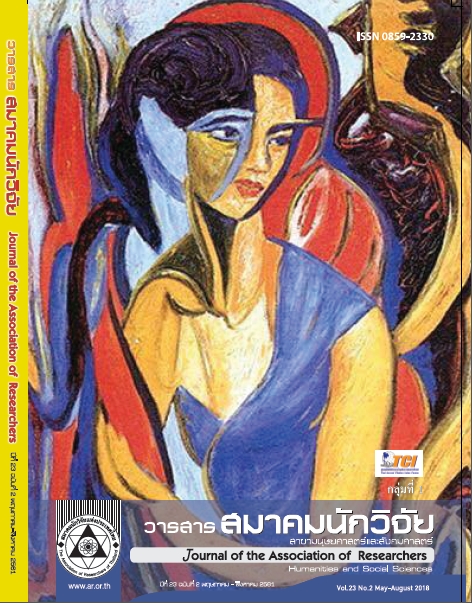Impact Pathway of Sugarcane and Sugar Researches in Thailand
Main Article Content
Abstract
Impact assessment plays an important role for management and allocation of research investments to deliver highest benefit to society. This research principally aims to evaluate the impacts of sugarcane and sugar researches in Thailand. The data are obtained from the National Research Management System: NRMS during 2008 – 2016. Primary data from various stakeholders are assembled to analyze sugarcane research status, inputs, outputs, outcomes and impacts. The results showed that there were positive impacts from sugarcane researches. The highest impacts were on economics, followed by environment and social impacts respectively. The suggested direction of sugarcane researches includes continuing research support throughout the value chain. Especially, a strong support on upstream sugarcane research is still required, e.g. varietal improvement, machinery, pest management. Moreover, upscaling the research outputs from laboratory to commercial scales is crucial in order to gain the highest benefits from sugarcane researchers to Thai society.
Article Details
บทความที่ปรากฏในวารสารนี้ เป็นความรับผิดชอบของผู้เขียน ซึ่งสมาคมนักวิจัยไม่จำเป็นต้องเห็นด้วยเสมอไป การนำเสนอผลงานวิจัยและบทความในวารสารนี้ไปเผยแพร่สามารถกระทำได้ โดยระบุแหล่งอ้างอิงจาก "วารสารสมาคมนักวิจัย"
References
ธัชพงศ์ เศรษฐบุตร. (2560). การพัฒนาสมรรถนะนักทรัพยากรมนุษย์ภาคอุตสาหกรรมเพื่อเตรียมความพร้อมสู่ประชาคม อาเซียน. วารสารสมาคมนักวิจัย ปีที่ 22 ฉบับที่ 2 พฤษภาคม - สิงหาคม 2560 176-190.
นงนุช อังยุรีกุล, เอื้อ สิริจินดา และสายทิพย์ โสรัตน์. (2558). การวิเคราะห์และสังเคราะห์งานวิจัยโครงการวิจัยอ้อยและ น้ำตาล เพื่อการจัดทำกลยุทธ์การวิจัย ปี 2557-2560. สำนักงานกองทุนสนับสนุนการวิจัย. กรุงเทพมหานคร.
พวงพรภัสสร์ วิริยะ, นาวิน มีนะกรรณ, พิพัฒน์ นนทนาธรณ์ และทิพย์รัตน์ เลาหวิเชียร. (2560). การวิเคราะห์โมเดลองค์ ประกอบของปัจจัยการตลาดเพื่อสังคมที่มีต่อพฤติกรรมการซื้อผลิตภัณฑ์ที่เป็นมิตรต่อสิ่งแวดล้อมของผู้บริโภค ในประเทศไทย. วารสารสมาคมนักวิจัย ปีที่ 22 ฉบับที่ 1 มกราคม - เมษายน 2560. 67-80.
มูลนิธิสถาบันวิจัยเพื่อการพัฒนาประเทศไทย. (2555ก). รายงานฉบับสมบูรณ์ โครงการการประเมินผลการวิจัยของ ประเทศ. นำเสนอต่อ สำนักงานคณะกรรมการวิจัยแห่งชาติ. กรุงเทพฯ: สถาบันวิจัยเพื่อการพัฒนาประเทศไทย.
มูลนิธิสถาบันวิจัยเพื่อการพัฒนาประเทศไทย. (2555ข). ตัวอย่าง รายงานการประเมินผลการวิจัยและพัฒนาของประเทศ ประจำปี 2554. นำเสนอต่อสำนักงานคณะกรรมการวิจัยแห่งชาติ.กรุงเทพฯ: สถาบันวิจัยเพื่อการพัฒนาประเทศไทย.
เยาวเรศ ทับพันธุ์. (2543). การประเมินโครงการตามแนวทางเศรษฐศาสตร์. กรุงเทพฯ: มหาวิทยาลัยธรรมศาสตร์.
สมพร อิศวิลานนท์ และสุวรรณา ประณีตวตกุล. (2547). การประเมินผลกระทบจากงานวิจัยทางวิทยาศาสตร์. ศูนย์วิจัย เศรษฐศาสตร์ประยุกต์ มหาวิทยาลัยเกษตรศาสตร์.
สมพร อิศวิลานนท์. (2557). ความท้าทายของอุตสาหกรรมอ้อยและน้ำตาลไทยภายใต้นโยบายการค้าเสรีโลก. กรุงเทพฯ: สถาบันคลังสมองของชาติ.
______________ (2559). ทำกินถิ่นอาเซียน: ไทยผู้นำการผลิต-ส่งออกน้ำตาลทรายของอาเซียน, 12 กุมภาพันธ์ 2559. http://www.komchadluek.net/news/lifestyle/222238
สำนักงานคณะกรรมการพัฒนาการเศรษฐกิจและสังคมแห่งชาติ. (2557). ข้อมูลอ้อยและน้ำตาลทราย เพื่อใช้ประกอบการ เยี่ยมชม โรงงานในกลุ่มน้ำตาลราชบุรี และโครงการสร้างโรงงานน้ำตาลที่จังหวัดกาญจนบุรี. กรุงเทพฯ: สำนักงาน คณะกรรมการพัฒนาการเศรษฐกิจและสังคมแห่งชาติ.
สำนักงานคณะกรรมการวิจัยแห่งชาติ. (2556). ยุทธศาสตร์การวิจัยรายประเด็นด้านอ้อยและน้ๆตาลทราย พ.ศ. 25562559. กรุงเทพมหานคร.
สำนักงานคณะกรรมการอ้อยและน้ำตาลทราย. (2558). รายงานการผลิตอ้อยและน้ำตาลทราย ปี 2557, 20 มีนาคม 2559. http://www.ocsb.go.th/th/home/index.php
สำนักงานเศรษฐกิจการเกษตร. (2558). พื้นที่การเพาะปลูก ผลผลิต และผลิตต่อไร่ของอ้อยในประเทศไทย, 10 มีนาคม 2560. http://www.oae.go.th/ewt_news.php?nid=13577
สุวรรณา ประณีตวตกุล. (2559). ทฤษฎีการเปลี่ยนแปลงและเส้นทางสู่ผลกระทบจากงานวิจัย. บทความในเอกสารประกอบ หลักสูตรการประเมินผลกระทบจากงานวิจัย สถาบันคลังสมองของชาติ. กรุงเทพฯ.
สุวรรณา ประณีตวตกุล, กัมปนาท วิจิตรศรีกมล และเอื้อ สิริจินดา. (2560). การประเมินผลกระทบของงานวิจัยด้านอ้อย และน้ำตาลในประเทศไทย. ศูนย์วิจัยเศรษฐศาสตร์ประยุกต์. คณะเศรษฐศาสตร์. มหาวิทยาลัยเกษตรศาสตร์ ศนูยว์จิยัเศรษฐศาสตรป์ระยกุต.์ (2547).
การศกึษาผลสำเรจ็ของงานวจิยัเกษตรทสี่งู โครงการหลวงในการพฒันาเทคโนโลย.ี กรุงเทพฯ: มหาวิทยาลัยเกษตรศาสตร์. อรณุวด ีเตง็ลอ่ไล.้ (2545). การวเิคราะหผ์ลตอบแทนทางเศรษฐกจิของการลงทนุในการวจิยัออ้ย. วทิยานพินธ ์วทิยาศาสตรมหาบัณฑิต. มหาวิทยาลัยเกษตรศาสตร์. กรุงเทพฯ.
ACIAR. (2008). Guidelines for assessing the impacts of ACIAR’s research activities. Australia: ACIAR Impact Assessment Series 58.
Angyureekul, Nongnuch, Aer Sirijinda and Saithip Sorat (2015). Analysis and Synthesis of Sugarcane and Sugar Research for a Development of Research Strategy for 2014-2017. Thailand Research Fund. Bangkok. Thailand. (in Thai).
Center for Applied Economics Research. (2004). Study on the Success of Highland Agricultural Research in Thailand. Bangkok: Kasetsart University. (in Thai).
Isvilanonda, Somporn and Praneetvatakul, Suwanna (2004). Impact Assessment of Science Researches. Bangkok: Center for Applied Economics Research of Kasetsart University. (in Thai).
Isvilanonda, Somporn. (2014). The Challenges of Thailand’s Sugarcane and Sugar Industry under the Global Free Trade Policy. Bangkok: Knowledge Network Institute of Thailand. (in Thai).
Isvilanonda, Somporn. (2016). ASEAN: Thailand’s leading producer and exporter of sugar. Retrieved February 12, 2016, from http://www.komchadluek.net/news/lifestyle/222238. (in Thai).
Jitmitrapap, Suthiporn. (2017). Research Standards and Publications. Khandker, S.R., G.B. Koolwal & H.A. Samad. (2010). Handbook on Impact Evaluation Quantitative Methods and Practices. USA: The World Bank. National Research Council of Thailand (2013). Strategic Research on Sugarcane and Sugar Research. 2013-2016. Bangkok. Thailand. (in Thai).
Nulty, D.D. (2008). The adequacy of response rates to online and paper surveys: what can be done? Assessment & Evaluation in Higher Education. Vol. 33, No. 3, June 2008, 301–314 Office of Agricultural Economics. (2015).
Planting Area, Yield and Production of sugarcane in Thailand. Retrieved March 10, 2017, from http://www.oae.go.th/ewt_news.php?nid=13577. (in Thai).
Office of The Cane and Sugar Board. (2015). Sugarcane and Sugar Production Report in 2014. Retrieved March 20, 2016, from http://www.ocsb.go.th/th/home/index.php. (in Thai).
Office of The National Economic and Social Development Board. (2014). Information on sugarcane and sugar to use for visiting Ratchaburi sugar factory and Kanchanaburi sugar factory. Bangkok: Office of The National Economic and Social Development Board. (in Thai).
Praneetvatakul, Suwanna (2016). Theory of Change and Research Impact Pathway. A document paper in Training program on Research Impact Assessment (RIA). Bangkok: Knowledge Network Institute of Thailand. (in Thai).
Praneetvatakul, Suwanna,Kampanat Vijitsrikamol and Aer Sirijinda. (2017). Impact Assessment of Sugarcane and Sugar Researches in Thailand. Bangkok: Center for Applied Economics Research of Kasetsart University. (in Thai).
Sattabut, Tatchapong. (2017). The Development of Human Resources Competency in Industry Sector to Provide the Readiness in ASEAN Community. Journal of the Association of Researchers. Vol.22 No.2 May - August 2017. 176-190. (in Thai).
Templeton, D. (2005). Outcomes: Evaluating Agricultural Research Projects to Achieve and to Measure Impact. Australia: Australian Center for International Agricultural Research. Tenglolai, Arunwadee. (2002). An Analysis of Economic Return on Sugarcane Research Investment. Master of Science in Agricultural Economics Thesis. Bangkok: Kasetsart University. (in Thai).
Thai Customs. (2016). Thailand Domestic Consumption and Export Data of Sugar. Retrieved March 20, 2016, from http://internet1.customs.go.th/ext/Statistic/ StatisticIndex2550.jsp. (in Thai).
Thailand Development Research Institute. (2012a). Final Report National Research Impact Assessment. Bangkok: Thailand Development Research Institute. (in Thai).
Thailand Development Research Institute. (2012b). Case Studies of Research and Development Evaluation 2011. Bangkok: Thailand Development Research Institute. (in Thai).
Tubpun, Yuavares. (2000). Project evaluation based on economic guidelines. Bangkok: Thammasat University. (in Thai).
Viriya, Phuangpornphat, N. Meenakan, P. Nonthnathorn and T. Laohavichien. (2017). Factor Analysis of Social Marketing Factors towards the Environmental Friendly Products Buying Behavior of Consumers in Thailand. Journal of the Association of Researchers. Vol.22 No.1 January - April 2017, 67-80. (in Thai).
Waibel, H. (2004). Principles of Impact Assessment of Research and Development in Agriculture and Natural Resource Management. Germany: The University of Hannover.


